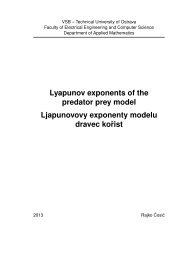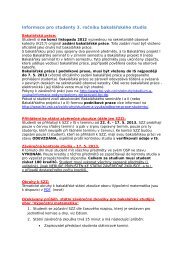The Boundary Element Method for the Helmholtz Equation ... - FEI VÅ B
The Boundary Element Method for the Helmholtz Equation ... - FEI VÅ B
The Boundary Element Method for the Helmholtz Equation ... - FEI VÅ B
You also want an ePaper? Increase the reach of your titles
YUMPU automatically turns print PDFs into web optimized ePapers that Google loves.
41Ano<strong>the</strong>r approach to computing <strong>the</strong> missing Neumann data is based on <strong>The</strong>orems 3.6and 3.7 suggesting that we may seek <strong>the</strong> solution in <strong>the</strong> <strong>for</strong>m of a single layer potentialor a double layer potentialu(x) = ( V κ s)(x) <strong>for</strong> x ∈ Ω (3.29)u(x) = −(W κ t)(x) <strong>for</strong> x ∈ Ω (3.30)with unknown density functions s, t. <strong>The</strong> density functions usually have no physical meaningand <strong>the</strong>se methods are thus called indirect. <strong>The</strong> representations (3.29) and (3.30) giverise to <strong>the</strong> boundary integral equationsand <strong>the</strong> corresponding variational problemsV κ s(x) = γ 0,int u(x) <strong>for</strong> x ∈ ∂Ω, (3.31)12 t(x) − (K κt)(x) = γ 0,int u(x) <strong>for</strong> x ∈ ∂Ω⟨V κ s, t⟩ ∂Ω = ⟨γ 0,int u, t⟩ ∂Ω <strong>for</strong> all t ∈ H −1/2 (∂Ω), 1κ2 I − K t, s = ⟨γ 0,int u, s⟩ ∂Ω <strong>for</strong> all s ∈ H −1/2 (∂Ω).∂ΩNote that <strong>the</strong> structure of (3.31) and (3.26) is similar, only <strong>the</strong> right-hand sides are different.Thus, <strong>for</strong> values of κ 2 not coinciding with an eigenvalue of (3.28) we have a uniquesolution to (3.31).Although <strong>the</strong> indirect approach can also be used <strong>for</strong> o<strong>the</strong>r types of boundary valueproblems, in <strong>the</strong> following sections we only consider <strong>the</strong> direct boundary element methods.3.5.2 Interior Neumann <strong>Boundary</strong> Value ProblemSolution to <strong>the</strong> interior Neumann boundary value problem∆u + κ 2 u = 0 in Ω,γ 1,int u = g Non ∂Ω(3.32)with a bounded Lipschitz domain Ω and <strong>the</strong> Neumann trace g N ∈ H −1/2 (∂Ω) is given by<strong>the</strong> representation <strong>for</strong>mulau(x) = ( V κ g N )(x) − (W κ γ 0,int u)(x) <strong>for</strong> x ∈ Ω (3.33)with unknown Dirichlet trace data γ 0,int u. Applying <strong>the</strong> Dirichlet trace operator to (3.33)we obtain <strong>the</strong> Fredholm integral equation of <strong>the</strong> second kind12 γ0,int u(x) + (K κ γ 0,int u)(x) = (V κ g N )(x) <strong>for</strong> x ∈ ∂Ω. (3.34)









